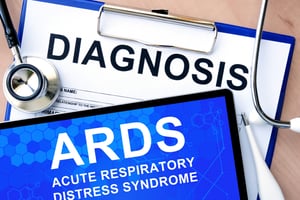Severe ARDS Management Considerations
The world is seeing more simultaneous Acute Respiratory Distress Syndrome, or ARDS, cases than ever before with the conception of COVID 19. ARDS is a progressive respiratory illness that can quickly become life threatening. Currently, two-thirds of infected Coronavirus individuals are diagnosed with ARDS.
As the patient’s lungs fill up with fluid and atelectasis persists, hypercarbia and hypoxia are  quick to follow. An increase in dyspnea ensues and the patient is likely to be sedated and intubated to improve oxygen delivery. Historically, ARDS is officially diagnosed for patients with PO2 <60 mmHg, pulse oximetry < 88% and a P/F ratio < 100. Additional parameters closely considered are the presence of bilateral infiltrates on chest x-ray and high serum lactates levels.
quick to follow. An increase in dyspnea ensues and the patient is likely to be sedated and intubated to improve oxygen delivery. Historically, ARDS is officially diagnosed for patients with PO2 <60 mmHg, pulse oximetry < 88% and a P/F ratio < 100. Additional parameters closely considered are the presence of bilateral infiltrates on chest x-ray and high serum lactates levels.
Management of ARDS patients is complex and requires diligence from the medical care team. Strategies for managing ARDS patients include:
- Low Tidal Volume Ventilation
- Targeting 6ml/kg predicted body weight
- High PEEP
- Optimizing PEEP will help reduce the peak inspiratory pressure and limit lung injury
- Heated humidifiers to better manage secretions
- Heated humidifiers and ventilator circuits are preferred over heat-moisture exchangers (HME). HME’s increase dead space and require changing frequently, causing loss of pressure within the circuit and potential for de-recruitment.
- Neuromuscular blockade/Sedation
- Eliminating the patient’s respiratory effort and possibly decreasing their metabolic rate can improve oxygenation
- Prone positioning
- Prone positioning directs ventilator pressures to the posterior lungs fields, which are much larger than anterior lung fields.
- Other more debated ARDS management include:
- Recruitment Maneuvers
- Inhaled Nitric Oxide
- Inverse I:E ratios such as APRV
Although there is evidence that these parameters improve oxygenation in patients suffering from ARDS, timing of these parameters and staff experience is always a factor. In extreme cases of ARDS, where the PaO2 remains <60 and ventilator pressures are dangerously high, ECMO should be considered. Another way to help determine ECMO candidacy is by calculating the patient’s oxygenation index (OI).
OI = Mean Airway Pressure x FiO2 x 100
PaO2
An OI greater than 40 can help medical teams seriously consider ECMO therapy for further treatment.
Articles referenced:
https://www.ncbi.nlm.nih.gov/pmc/articles/PMC4828494/




